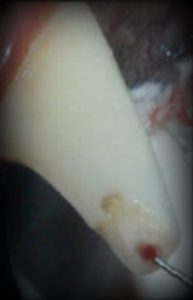 Has your dog chipped a tooth? It’s not uncommon; after all, many of a dog’s favorite activities involve using their teeth! A chipped dog tooth can occur while chewing on hard objects, such as bones and chews, or even playing with another dog. Luckily dog’s teeth come a little better equipped than ours in the department of durability.
Has your dog chipped a tooth? It’s not uncommon; after all, many of a dog’s favorite activities involve using their teeth! A chipped dog tooth can occur while chewing on hard objects, such as bones and chews, or even playing with another dog. Luckily dog’s teeth come a little better equipped than ours in the department of durability.
Sometimes a chipped dog tooth looks like nothing to worry about. But, whether it is, or not, shouldn’t be left to guessing. I say this simply because dogs are extremely good at masking their pain. Most times they go about their business as if nothing is wrong at all.
I suppose this is just one more reason we love our dogs; they never seem to complain!
Some signs that your dog may be in pain from a chipped tooth are loss of appetite, or losing interest in play. But, most often there will be no noticeable difference at all.
The most commonly chipped (fractured) teeth are the canine teeth (those sharp, pointy fang-like teeth), or the upper fourth premolar (large upper tooth toward the back – primary tooth used for chewing).
Below, I’ll discuss what problems can occur from a chipped tooth and why it is always important to have it checked out by a professional.
The most common type of tooth fractures are crown fractures. The two main types are called “complicated crown fracture” and “uncomplicated crown fracture.
 Complicated Crown Fracture in Dogs
Complicated Crown Fracture in Dogs
A complicated crown fracture directly involves the root canal. This is the worst type of fracture and is when the tooth breaks and exposes the pulp (blood vessels and nerves) underneath. And, although a dog may not show any signs, it is extremely painful.
Once the pulp is exposed, bacteria from within the mouth gains access into the root canal system and infects the tooth. If not treated, the tooth will eventually die. Bacteria will continue to be an issue as it can then leak out the bottom of the tooth and infect the underlying bone. From there it can be picked up in the bloodstream and be transported to the rest of the body damaging vital organs such as the heart, liver, kidney and brain.
Initially, a complicated fracture appears as a pink spot on the tooth (pulp exposure). Once the tooth dies, the nerve becomes dark and appears as a black spot on the tooth.
You can see why it is very important for this type of tooth fracture to be addressed! Not only is it painful, but is also dangerous to your dog’s health.
A professional can fix the problem by determining if you dog needs a root canal (yes, dogs can get them too!), or a tooth extraction. Vital pulp therapy (VPT) can be used for a very recently fractured tooth (a treatment used to keep the pulp alive); however, root canal is usually recommended as the better treatment. VPT is usually reserved for dogs less than 18 months, with fractures that occurred under 48 hours.
 Uncomplicated Crown Fracture in Dogs
Uncomplicated Crown Fracture in Dogs
An uncomplicated crown fracture is when a tooth gets chipped and exposes the dentin underneath (the pulp is not exposed). Dentin makes up around 80% of the tooth structure and is located under the enamel. The enamel on a dog’s tooth is very thin, so when it chips there is a high likelihood of dentin exposure.
This type of fracture will cause sensitivity in the tooth, and can be painful. Think of how it feels to have a toothache and you will begin to understand what your dog can be feeling.
A brown area on the tooth may signify exposed dentin. Although there may appear to be minimal damage to the tooth, bacteria can still get into the root canal system and lead to infection.
To assess the tooth, it is recommended that the tooth be radiographed. If there is no evidence of infection, and no direct root canal exposure, the tooth can be treated by smoothing it, and applying a bonded sealant. This will block any sensitivity your dog may have been feeling in that tooth, and also block infection.
Things to Remember if Your Dog Chipped a Tooth
- Dogs tend to suffer in silence, so even if you dog is in pain, he may not show any outward signs of discomfort
- A chipped tooth may look minor, but always have it checked out to ensure it’s not worse than it appears; it may need treatment
- Not having a proper assessment of a chipped tooth can doom your dog to lifelong chronic pain

